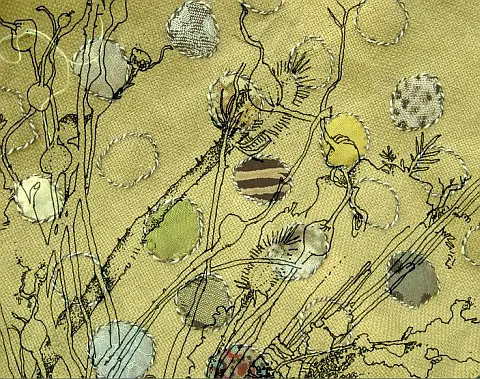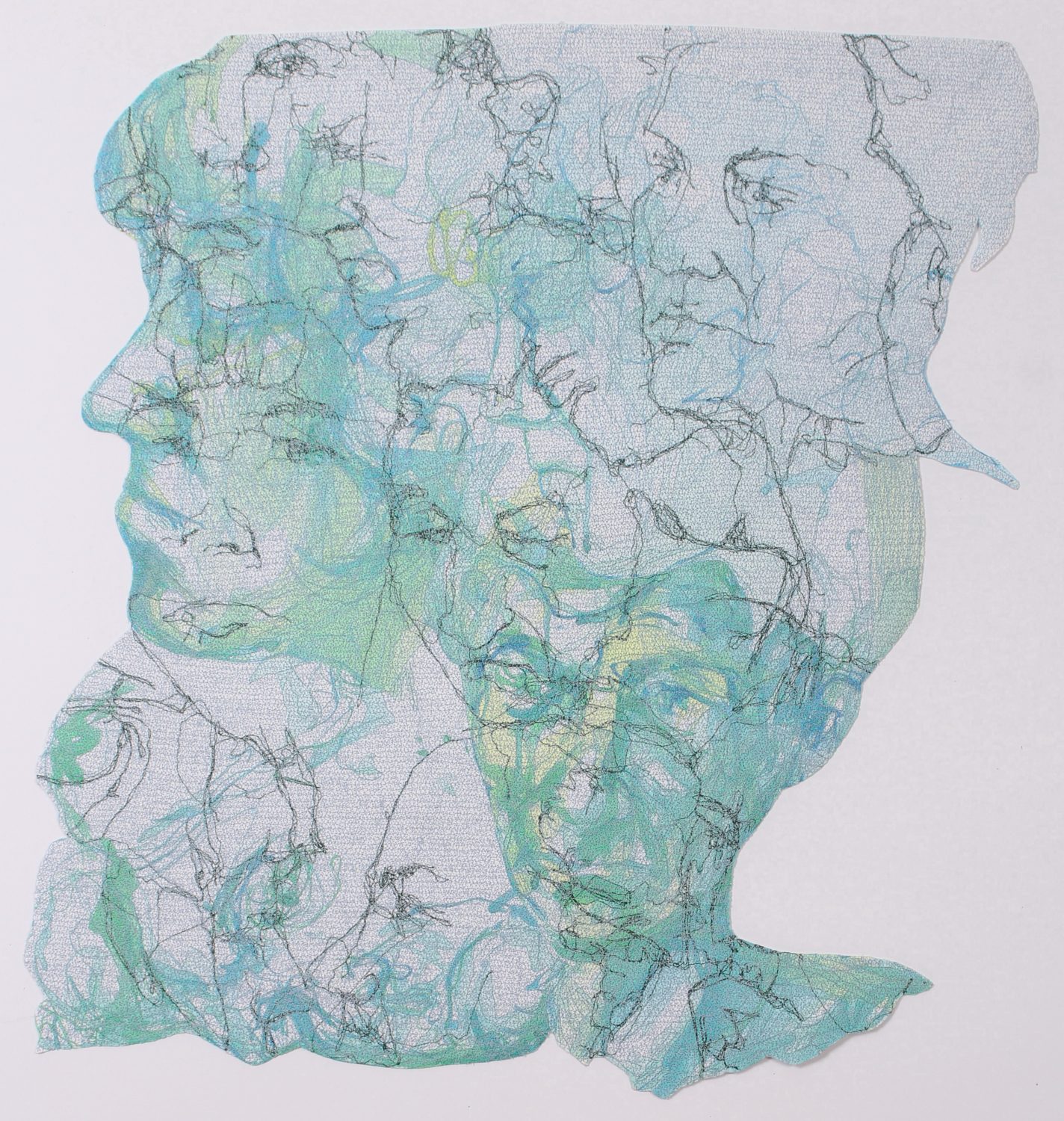
Welcome to ARTeries where we lead you to broader interpretations of “embroidery”. In the dictionary, it’s defined as “Embroidery: the art or handicraft of decorating fabric or other materials with needle and thread or yarn,” but in our lexicon it means everything from “classic” embroidery to art quilting, mixed media, sculpture, book and paper arts, with new methods, old techniques revisited, and the weird and wonderful.
Jude Hill is an embroidery artist synonymous with a simplicity of style and a respect for the inherent beauty of old cloth. She is expressive with original approaches to handling her materials, never stridently forcing them into concept or statement, though they are persuasive stories in themselves.
Many of you may know of, or follow, the artist I’m profiling in this ARTeries post. I thought we’d start with the familiarity of hand stitch and the “easy”. That’s not to say that this artist creates art that doesn’t say anything, or that her methods result in simplistic pieces; in fact, her works are deep and richly layered with meaning and nuance, her craftsmanship is impeccable and she constantly stretches our definitions of what thread and cloth “should” do.
Magical beings, familiar flora and fauna, common symbols and surprising juxtapositions of colour and texture make her work distinctive and accessible.

With respect, reverence and a dry sense of humour, her art is reaching, and touching, a wide audience. I find it quite compelling that often the responses to her work are as eloquent and thoughtful as the work that prompted the observation. I asked Jude if she would answer several questions about herself and her work, and she graciously consented.
What is it about hand stitch that makes you focus on such a low tech method? I know you’re not a Luddite as you have a very obvious web presence, so why are there no machine experiments? Was there ever a journey back to “the basics”, or is that where you always were travelling?
For me the hand stitch is close to breathing. It is meditative and contains a rhythm that is healing in a fast paced world. And it is so simply functional. I like to think of it as needle chanting. My work is more about a conversation with the fabric, I am listening to its story. A sewing machine often drowns out the voice of the fabric with the scream of hurry: I also don’t like much the look of a machine stitch or the limitation of being near electricity. I mean I want to sew all the time, I don’t enjoy being a shut in. Although seemingly primitive, hand stitching is actually just as efficient as machine sewing if speed is not an issue. Also the machine cannot distinguish and separate layers, which is key to my hide and seek layered technique… I have actually done some machine experiments which I call “electric jude” – Mostly for piecing, to understand the technique and where the stitches don’t show. . but I always return to hand sewing. So I have to say basic is where I started and basic is where I am headed.

You seem quite prolific, given the labour intensive techniques you use: how many pieces are you usually working on at once? Any idea of how many you’ve made over the years?
I work on many pieces, as many as possible. I think they are all part of what I am doing, have done and will ever do, all steps in one large journey. I am never really finished with any of them, I just stop and either give them away or decide to sell them at one point. I always refer to old work for technique and inspiration, continuing the ones that are gone, through another new piece. So … I work on all of them at once, in a way. They are connected. Right now I count 52 WIPs (works in progress) in my studio…
When you do something all the time, even if you move too slowly for others to notice, the constant motion produces surprising volume and achievement. I have made by hand 13 full size spirit cloths/quilts and 260 smaller pieces, most of which have been given away. (But who’s counting?) Ha! I am a people powered stitching machine!
You also make it look easy! Is there ever a time you have difficulty in execution, or suffer any angst with a piece?
As my mother always says “anything is easy if you know how.” I know “how” in a sense because of all the years I have been creating with cloth. It comes to me without too much thought. I spend most of my time creating story. I do stumble but I have no angst, I just pause and find a way to keep going. Sewing is a marvelously simple concept. It is trial and error, and so satisfying to make something out of almost nothing. I find no stress in it. The only issues are occasional stopping points in how to communicate an idea. I get around that by telling a story as I go.
What’s your favourite story from all of your work?
I once met a woman, a friend to my son. She visited me and told me she was building a treehouse in the forest. I liked her. I never saw her again but I spent the next 7 months making her a quilt, using the feelings I got from our only meeting, the “treehouse quilt”, my favorite piece of all time. A story cloth of nature and myth and the return to Mother Earth. I sent it to her. She loved it. It lives in the treehouse. Just to add another detail, she started a blog to record the building of the treehouse.( my son designed it) I blogged the whole process of the quiltmaking so she could watch and this is how I started blogging. Unfortunately one day shortly after finishing, I became frustrated with all this internet stuff and deleted it… I started the spirit cloth blog shortly after. Funny how things happen.

The circle, dot, spot crops up quite often in your work. Why are these symbols important to you?
I wouldn’t call them “important”. I suppose it just a natural phenomenon, and I deal with it. I have noticed that this happens to many others…round is just sort of everywhere. The meaning comes when I use elements in a story. Since I have been using dots a lot this year, they have become important elements of the story on the cloth. They are an experiment in making “characters” of design elements…
Where does art fit into your life and where do you see yourself in a year?
I never really thought about fitting art anywhere. Actually I don’t even separate it from what living is. I cannot imagine living without it. In a year, I don’t know. I’d love to be living on a mountainside overlooking the sea – with goats and maybe a donkey. I’d love to be stitching cloths to give away to the local inhabitants – but really I just hope I don’t have to return to working 9-5, I hope I can keep doing what I am doing, sell enough here and there to make ends meet and work on some things that have been in my head too long. I hope that I am alive and well and sewing.

Jude’s work gives credence to the purposing of materials, proving that no precious scrap is too small to be unappreciated, no stray thread a mistake, and that mistakes, while they do happen, can be made into beauty. Her primary tool is the running stitch, in a Kantha style use. Kantha originated in Bangladesh and India centuries ago, as a way for old fabrics to be patched together to extend their usefulness, and often became works of art in themselves, with regional differences influencing the designs. Jude has taken this style into her own and creatively embraces history and contemporary sensibility with it.
If you haven’t already become a fan of Jude’s, please visit her Instagram. If you are interested in learning more about Kantha, we have a fantastic book review for you, or you start your research with a basic explanation at Wikipedia.



